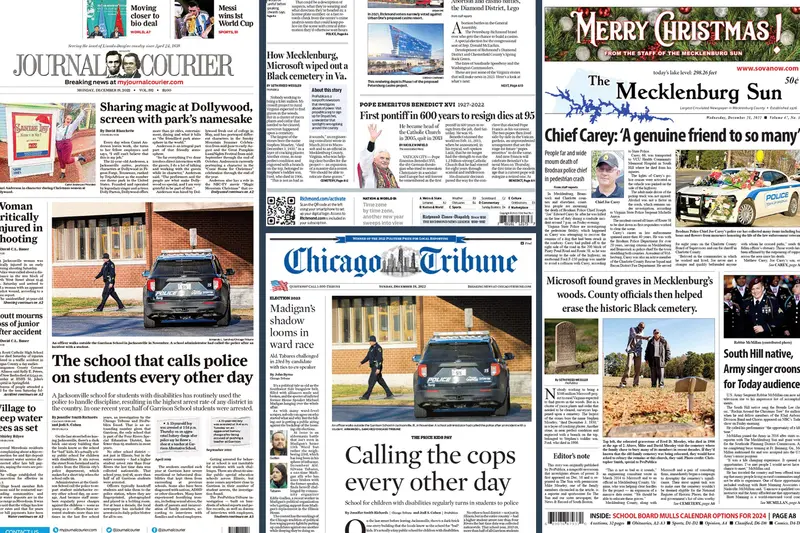How News Articles can Save You Time, Stress, and Money.
How News Articles can Save You Time, Stress, and Money.
Blog Article
The Facts About News Articles Revealed
Table of ContentsNews Articles - TruthsThe 3-Minute Rule for News ArticlesFascination About News ArticlesNews Articles for Dummies4 Easy Facts About News Articles Shown
Great knowledge of various topics offers trainees an one-upmanship over their peers. Despite the fact that electronic and social media are conveniently available, we must not neglect how crucial it is to review the papers. Parents have to try and instill the behavior of reviewing a newspaper as a daily regimen to proceed the heritage of the adored print tool.News tales likewise contain at least one of the following crucial features loved one to the intended target market: closeness, prestige, timeliness, human rate of interest, quirk, or repercussion.
Within these restrictions, newspaper article likewise intend to be thorough. Nonetheless, other variables are included, some stylistic and some derived from the media type. Among the larger and extra revered papers, fairness and equilibrium is a major consider offering info. Commentary is usually constrained to a separate area, though each paper may have a various general slant.
Papers with an international audience, for example, have a tendency to make use of an extra formal design of creating. News Articles.; common style guides consist of the and the United States Information Design Publication.
10 Easy Facts About News Articles Explained
Generally, journalists will not utilize a long word when a short one will certainly do. They make use of subject-verb-object building and dazzling, energetic prose (see Grammar). They offer narratives, examples and allegories, and they rarely depend on generalizations or abstract ideas. Information writers attempt to prevent utilizing the same word greater than when in a paragraph (sometimes called an "resemble" or "word mirror").
Headlines sometimes omit the topic (e.g., "Leaps From Watercraft, Catches in Wheel") or verb (e.g., "Pet cat female fortunate"). A subhead (additionally subhed, sub-headline, subheading, subtitle, deck or dek) can be either a subordinate title under the main heading, or the heading of a subsection of the short article. It is a heading that precedes the major text, or a group of paragraphs of the major message.

Extra billboards of any of these types may appear later on in the write-up (especially on succeeding pages) to lure further analysis. Such signboards are additionally made use of as pointers to the short article in other sections of the magazine or site, or as promotions for the item in other publication or websites. Typical framework with title, lead paragraph (recap in vibrant), various other paragraphs (information) and get in touch with details.

Instance of a see post hard-lead paragraph NASA is proposing an additional area task. The budget demands around $10 billion for the project.
The NASA news came as the firm requested $10 billion of appropriations for the project. An "off-lead" is the 2nd most important front web page news of the day. The off-lead appears either in the leading left corner, or straight below the lead on the. To "bury the lead" is to start the short article with background info or details of secondary importance to the readers, requiring them to learn more deeply into a write-up than they ought to have to in order to find the necessary factors.
How News Articles can Save You Time, Stress, and Money.
Common use is that a person or two sentences each develop their own paragraph. Journalists normally define the company or structure of a news tale as an inverted pyramid. The important and most interesting components of a tale are put at the start, with sustaining info adhering to in order of diminishing relevance.
It enables people to check out a subject to just the depth that their inquisitiveness takes them, and without the imposition of information or subtleties that they could consider pointless, however still making that info available to extra interested visitors. The inverted pyramid framework also makes it possible for articles to be cut to any approximate size throughout format, to suit the room available.
Some authors start their stories with the "1-2-3 lead", yet there are numerous kinds of lead readily available. This layout inevitably begins with a "Five Ws" opening up paragraph (as explained over), followed by an indirect quote that offers to support a major element of the initial paragraph, and afterwards a direct quote to support the indirect quote. [] A twist can refer to numerous points: The last story current broadcast; a "delighted" story to finish the program.
Longer write-ups, such as magazine cover write-ups and the pieces that lead the within sections of a newspaper, are called. Feature stories differ from straight news in numerous methods. Foremost is the absence of a straight-news lead, the majority of the time. Rather of useful reference providing the significance of a tale in advance, attribute authors might attempt to additional reading entice readers in.
The Ultimate Guide To News Articles
A function's very first paragraphs frequently relate a fascinating minute or occasion, as in an "anecdotal lead". From the particulars of an individual or episode, its sight rapidly broadens to abstract principles concerning the story's topic.

The Editor's Toolbox: A Reference Overview for Beginners and Professionals (2001) Allan M. Siegal and William G. Connolly. The New York Times Handbook of Style and Usage: The Official Style Guide Made Use Of by the Writers and Editors of the Globe's The majority of Authoritative Paper (2002) M. L. Stein, Susan Paterno, and R.
Report this page